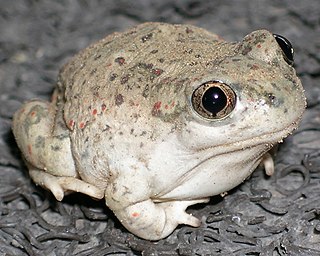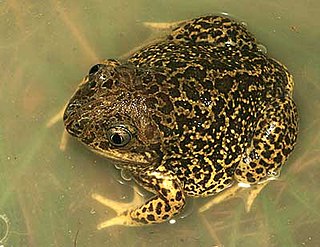
Megophryidae, commonly known as goose frogs, is a large family of frogs native to the warm southeast of Asia, from the Himalayan foothills eastwards, south to Indonesia and the Greater Sunda Islands in Maritime Southeast Asia, and extending to the Philippines. Fossil remains are also known from North America. As of 2014 it encompasses 246 species of frogs divided between five genera. For lack of a better vernacular name, they are commonly called megophryids.

Spea hammondii, also known as the western spadefoot, western spadefoot toad, Hammond's spadefoot, or Hammond's spadefoot toad, is a species of amphibian in the family Scaphiopodidae. It is found in western California (USA) and northwestern Baja California (Mexico). The specific name hammondii is in honor of physician and naturalist William Alexander Hammond.

Couch's spadefoot toad or Couch's spadefoot is a species of North American spadefoot toad. The specific epithet couchii is in honor of American naturalist Darius Nash Couch, who collected the first specimen while on a personal expedition to northern Mexico to collect plant, mineral, and animal specimens for the Smithsonian Institution.

Hurter's spadefoot toad or Hurter's spadefoot is a species of American spadefoot toad found in the south central United States ; its range might extend to the adjacent northern Mexico. It was once classified as a subspecies of the eastern spadefoot toad, but it has been granted its own species status. The specific name hurterii is in honor of the Swiss-American naturalist and curator of the St. Louis Academy of Sciences, Julius Hurter.

The New Mexico spadefoot toad is a species of American spadefoot toad found in the southwestern United States and Mexico. Like other species of spadefoot toad, they get their name from a distinctive spade-like projections on their hind legs, which enable them to dig in sandy soils. Spea multiplicata can be identified by its wedge-shaped spade. Some sources also refer to the species as the Mexican spadefoot toad, desert spadefoot toad or southern spadefoot toad.

Xenophrys major is a species of toad found in northeastern India, Burma, Thailand, Cambodia, Laos, Vietnam, and southern China. It has recently been reported also from Bhutan.
Boulenophrys parva is a specie of horned frog found in South Asia, Southeast Asia, eastern India, Nepal, Bangladesh, Burma, western Thailand, southern China, northern Laos and Vietnam. Perhaps because of its wide distribution, Boulenophrys parva is known under many common names, including concave-crowned horned toad, lesser stream horned frog, mountain horned frog, brown horn frog, Burmese spadefoot toad, and small spadefoot toad. It inhabits evergreen broadleaf forests alongside streams.
Xenophrys robusta, commonly known as the Bengal spadefoot toad, robust spadefoot toad, or white-lipped horned toad, is a species of toad found in eastern Nepal and north-eastern India. It is associated with riparian vegetation in tropical moist forests.

Xenophrys glandulosa, the glandular horned toad or Jingdong spadefoot toad is a species of amphibian in the family Megophryidae found in Yunnan in China, in Nagaland in northeastern India, and in northern Kachin State, Myanmar. It has recently been reported from Bhutan. Its type locality is Mount Wuliang in Jingdong County, Yunnan. Its natural habitats are tropical moist montane forests and rivers.

Scaphiopus holbrookii, commonly known as the eastern spadefoot, is a species of American spadefoot toad endemic to the eastern United States. It is not considered a true toad, with Bufonidae being the family of "true toads".

Xenophrys aceras, commonly known as the Perak horned toad, Perak spadefoot toad or Malayan horned frog, is a species of frog in the family Megophryidae found in Peninsular Malaysia and Thailand, and possibly in Indonesia. Its common name refers to its type locality, Bukit Besar in Perak state, Malaysia.

Xenophrys is a genus of amphibians in the family Megophryidae. They are found in southeastern Asia to Borneo. Their common name is strange-horned toads.

The Kinabalu horned frog or Balu spadefoot toad is a species of amphibian in the family Megophryidae. It is endemic to northeastern Borneo in Sabah, Malaysia. Its natural habitats are subtropical or tropical moist montane forests and rivers.

Xenophrys longipes is a species of frog in the family Megophryidae. It is also known as the Malacca spadefoot toad, red legged spine-eyed frog, red-legged horn frog, and slender-legged horned frog. It is found in the Malay Peninsula. Records from Cambodia and Vietnam are considered doubtful.
The Mangshan horned toad, or Mangshan spadefoot toad, is a species of frog in the family Megophryidae. It is endemic to China and known only from southern Hunan and northern Guangdong; its type locality is Mount Mang (Mangshan) in Yizhang County, Hunan. Its natural habitats are subtropical or tropical moist lowland forests, subtropical or tropical moist montane forests, and rivers. It is threatened by habitat loss.
The Medog horned toad, or Medog spadefoot toad, is a species of frog in the family Megophryidae. It was described as a subspecies of Omei horned toad based on specimens collected from Mêdog County, Tibet (China); it is still only known from its type locality. It probably has a wider distribution that may reach India. Its natural habitats are subtropical or tropical moist lowland forests, subtropical or tropical moist montane forests, and rivers.
The Omei horned toad, also known as the Mount Omei spadefoot toad, is a species of frog in the family Megophryidae. It is found in Sichuan and Tibet in China, including the type locality, Mount Emei and possibly in Vietnam. Its natural habitats are subtropical or tropical moist lowland forests, subtropical or tropical moist montane forests, and rivers. It is threatened by habitat loss.
Zhang's horned toad, or Zhang's spadefoot toad, is a species of frog in the family Megophryidae. It was formerly only known from Zhangmu, Nyalam County, Tibet, China, but is now known to be widespread throughout Nepal and also to inhabit four locations in India.

The Great Basin spadefoot is an amphibian in the family Scaphiopodidae. It is 3.8 to 6.3 centimetres long and is usually colored gray, olive or brown. Great Basin spadefoot toads have adapted to life in dry habitats. They use the hard, keratinized spade on each foot to dig a burrow, where they spend long periods during cold and dry weather. They are opportunistic hunters and will eat anything they can subdue. While their tadpoles have numerous predators, adults are able to produce skin secretions that deter enemies.

The Pelobatoidea are a superfamily of frogs. They typically combine a toad-like body shape with a frog-like, pointed face. Phylogenetically they stand between primitive frogs on the one side and higher frogs on the other and are therefore – among other things by characteristics of bone construction – in the suborder Mesobatrachia.













